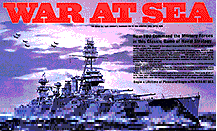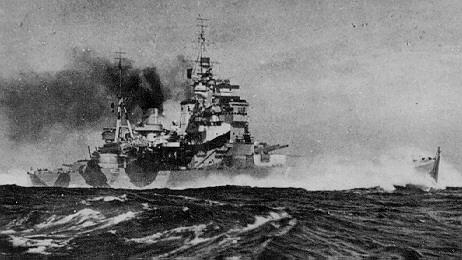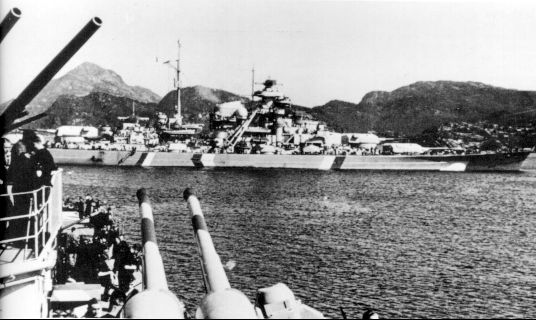

Keys to Allied Victory:
1. Restricting Axis Movement
2. Forcing Favorable Combat
3. Controlling U-boats
4. Delivering Convoys
Movement: 1) Because a large portion of your heavy firepower is also very slow, you will have to choose whether or not to contest the Mediterranean on the first turn and live with that choice. 2) Unless the Kriegsmarine has been significantly damaged, you will be unable to garrison all of the areas on the board effectively. Four areas is usually the maximum; less if you've taken heavy casualties. Work to establish control flags (first in the North Sea and then the Barents Sea and South Atlantic) that restrict Axis movement, allowing you to control more areas. 3) Determine your goal for each area. To win, you'll need 50% more firepower than the expected German firepower to compensate for the +1 bonus shot (or a slight edge against the Italians). To cause damage or intimidate the Axis, you'll need a similar amount of firepower and ships or fewer ships with greater firepower. To siphon off strength from other battles while presenting a target too tempting to pass up, use the minimum number of ships to attract the desired attention. If you can't achieve a goal, don't patrol! 4) Carriers can be used to buttress areas that cannot quite achieve their goal with surface firepower alone.
ASW & U-boats: Develop a strategy against the wolfpack. To beat the U-boats or intimidate the Axis, you need around three ASW per U-boat; use this strategy to protect convoys and vital movement lanes. To cause damage, use about 1.5-2 ASW per U-boat. If you decide not to protect movement lanes (e.g., turn 8), spread the ASW evenly to make it difficult for the U-boats to deny control of multiple areas.
Combat: 1) Any combat that causes nearly even losses on both sides is excellent! You can afford losses. Try to draw the Kriegsmarine into any battle where expected German losses are high. 2) Target the smaller German ships (in an attempt to sink them) if you expect to lose. 3) In close battles, spread your fire among Axis ships to take advantage of your relatively greater ability to disable. 4) If you expect to win, concentrate fire to sink key ships.
Disengaging: 1) Include cruisers in forces that have carriers to provide an escort should you need to flee at high speed. 2) Run when no goal can be accomplished by continuing! 3) Run in multiple groups if overall damage to your fleet will be minimized.
Basing & Repair: 1) In the Med, surviving ships have the option of returning to England. Leave enough ships to handle the Italian fleet and return the heavily damaged to England. 2) If England's repair facility is or will be overloaded, return fast ships to the USA. 3) Repair BBs with max. damage (except turn 8); otherwise, only if your goals can be achieved without them.
Convoys: 1) The convoys represent a 9 PoC opportunity. Guard them well, but not so well as to let the German fleet run rampant elsewhere. 2) Guard a convoy just enough to let the Axis win at the expense of losing so many ships that you will win the game.
U.S. & Russian Forces: 1) US forces are more expendable than British ships. Baring convoys, the North Atlantic is an excellent place to attrition the German fleet. 2) Make sure the Russians can accomplish an objective before deploying them! Don't deploy just because you can (until turns 7-8).
Italian Forces: 1) Never send less force against the bulk of the Italian fleet than is necessary to win. 2) Ignore Italian BBs unless you've chosen a Mediterranean Strategy.
Keys to Axis Victory:
1. Mobility (Maximizing Threat)
2. Preservation of Fleet
3. Attrition of British ASW forces
4. Destroying Convoys
Movement: Your key is to determine the weakness in the Allied position and exploit it. 1) Do not move your ships into an even battle. The Allies would love nothing better than to trade ships (even two for one)! 2) Consider the mobility impact of any decision on the following turn. ASW & U-boats: 1) U-boats are most difficult to stop when massed in large numbers. Avoid early losses in minor battles to reach full strength quickly. 2) When supporting the fleet, use U-boats against battleships; otherwise, torpedo carriers and convoys to minimize future ASW. 3) Use U-boats to deny Allied control of areas you wish to be able to move through. 4) Use U-boats aggressively turn 4 and 5 since you can replace losses easily.
Combat: 1) Never enter a fight you expect to lose. Keep the firepower and ship advantage! 2) Six bonus shots will normally sink anything the British have; four is often enough. 3) The longer the battle, the worse. Multiple rounds allow the Allies to finish off ships that you'd rather repair! 4) If forced to fight a close battle, consider U-boat support to reduce losses and win quickly.
Disengaging: 1) Your ships are faster, in general, which can allow you to escape. 2) If you're in a losing situation, don't continue to lose ships! The Allies win even trades!
Basing & Repairs: 1) Repair ships unless an opportunity exists that is worth the loss of the ship. 2) Choose the base where movement options are the greatest. 3) Oil at sea if the Allies do not control the South Atlantic (or if the resulting threat is greater than the risk).
Convoys: 1) The Luftwaffe only has a 25% chance to stop a convoy on its own. 2) A 3 PoC sea area is worth just as much as a convoy - more if it opens movement lanes!
U.S. & Russian Forces: 1) Don't waste your ships against the US unless some other vital objective can be achieved. 2) Eliminate the Russian nuisance as soon as reasonable.
Italian Forces: Just because the Italians get a chance to fight does not mean that you should. Do not allow a meaningless blow-out.
PoC: Keep a fine balance between long-term goals and short-term PoC. A long-term methodology is worth more than 1-2 PoC in the first few moves. However, in a close match, the PoC count will become crucial in every decision. Weigh the use of each ship, sub, carrier, and airstrike for the expected return throughout the game.
Land-based Air (LBA) & Airstrikes: When you get a choice, shoot at the more critical target (e.g., the Allies should shoot at German ships rather than Italians even when there are fewer German targets unless competing for the Med). Axis LBA can dramatically assist U-boats by targeting carriers. Airstrikes, LBA, and U-boats are your chance to alter the composition of the enemy fleet before the main battle begins. Target the ships with the greatest firepower (weakest first) in close battles or weaker ships that you may be able to sink if attrition is your goal.
Luck: Keep the proper balance between each demand for resources and luck will be with you!
Strategy: Establish a complete blockade of Germany in a two turn approach that avoids early losses.
Implementation: Divide your fleet between the North Atlantic, North Sea, and South Atlantic (with emphasis on the later two since more Axis ships can reach those).
Keys to Success: Each area should be strong enough to defeat any Axis incursion. Once control of the North Sea is established, it must be maintained in order to prevent a strong Axis sortie into the South Atlantic (which allows the Allies to garrison the South Atlantic against U-boats and Italian cruisers only). The heavily patrolled areas on turn two should be the Barents Sea, North Sea, and North Atlantic to finish the blockade.
Weaknesses: Surrenders a 2 PoC lead after turn one by giving up the Barents Sea. Does not cause German losses early in the game which makes the U-boat war more critical. Surrenders the Mediterranean to the Italian navy permanently (2 PoC/turn).
Strategy: Establish a complete blockade of German on turn one and cause heavy losses in the Kriegsmarine that will make it easier to maintain the blockade and get convoys through.
Implementation: Send all of the fast ships (speed 6-7) to the Barents Sea while strongly patrolling the North Sea. Then, depending on where you'd like the Kriegsmarine to attack, split your remaining battleships between the North and South Atlantic. The advantage of making the South Atlantic weaker is that German ships will be unable to repair damage and unwilling to stay in the Neutral Port. The advantage of making the North Atlantic weaker is that Axis control does not open up movement lanes and that ships that oil at sea risk being trapped in the South Atlantic on turn two.
Keys to Success: The Axis must not be able to take two contested areas on turn one. Hopefully, the Axis even feel uncomfortable enough in their attack that they cannot spare a ship to patrol the Baltic Sea. The Axis must lose two-three ships if they contest the North or South Atlantic. The blockade must be maintained - especially the North Sea!
Weaknesses: Gives up a 2-3 PoC lead to the Axis on turn one. Permanently surrenders the Mediterranean to the Italian navy. A big group of German oilers could negate the effect of the blockade.
Strategy: Establish control of the Mediterranean and North Seas while delivering extensive damage to the Italian and German navies in order to ultimately make the South Atlantic and Mediterranean easy for the Allies to control turn after turn.
Implementation: Ignore the Barents Sea. Send a force equal to the Italian navy to the Mediterranean along with a good carrier to give you the edge. Defend the North Sea and South Atlantic with a force adequate to give the Axis second thoughts (or, at least, major damage). Patrol the North Atlantic with as many Battleships as you can (usually two or three) simply to cause damage and prevent a huge fleet of oiled ships.
Keys to Success: Italian fleet must take heavier damage than the Allied fleet so that part of the Med fleet can be transferred to the Atlantic by the end of turn two. German fleet must take significant damage (two ships) if it takes the North Atlantic or extremely heavy losses (four-five ships) if either the North Sea or South Atlantic is taken. If the Italians refuse to fight and the Germans refuse to fight or take heavy losses, abandon the Med.
Weaknesses: Gives the Germans an easy 3 PoC lead (unless the Germans are intimidated enough by the North Atlantic fleet to leave the Baltic unpatrolled). Failure to attrition the Italian fleet significantly will either force abandonment of the Mediterranean or, in the event of defeat, may require reinforcements or spell the Allies' doom altogether.
Strategy: Cause irreparable damage to the German fleet.
Implementation: Divide your forces as evenly as possible between the four Atlantic areas (with a little extra in the North Sea and Barents to compensate for the lack of German speed rolls and a little extra in the South Atlantic to handle the Italians). Allocate extra air factors to compensate for inequalities.
Keys to Success: The German fleet must either fight and suffer severe damage (four-five ships) or cower in port (surrendering a 1 PoC lead and giving you a blockade - see Barents on One).
Weaknesses: The expected loss is likely to open movement lanes for the Axis. Axis may take a 2 PoC lead. Carriers may be lost on the first round - making the U-boats harder to stop. Failed speed rolls to the Barents may create an imbalance.
 |
The indefatigable Bruce Monnin has just published the The Boardgamer's Unofficial Guide to War At Sea. A wealth of information, available from Bruce for $7 at (e-mail) monninb@bright.net or (postal) 177 South Lincoln Street, Minster, OH 45865-1240.
A site with AREA ratings for every player in every game is maintained by
Bruno Wolff III at:
<www.uwm.edu/people/bruno/AREA>.
The Boardgame Players Association, which has all the latest information about the World Boardgaming Championships, is at: <http://www.boardgamers.org>.
Another good site is ConsimWorld, "the official news, information, and talk site covering the historical boardgaming industry," which includes discussions on a wide variety of gaming topics, including Avalon Hill, product releases from a number of companies, and specific games like War At Sea. The URL is: <www.consimworld.com>.
Finally, Web-Grognards advertises itself as "the site for wargames on the web." Check them out at: <www.grognard.com>.
 |
